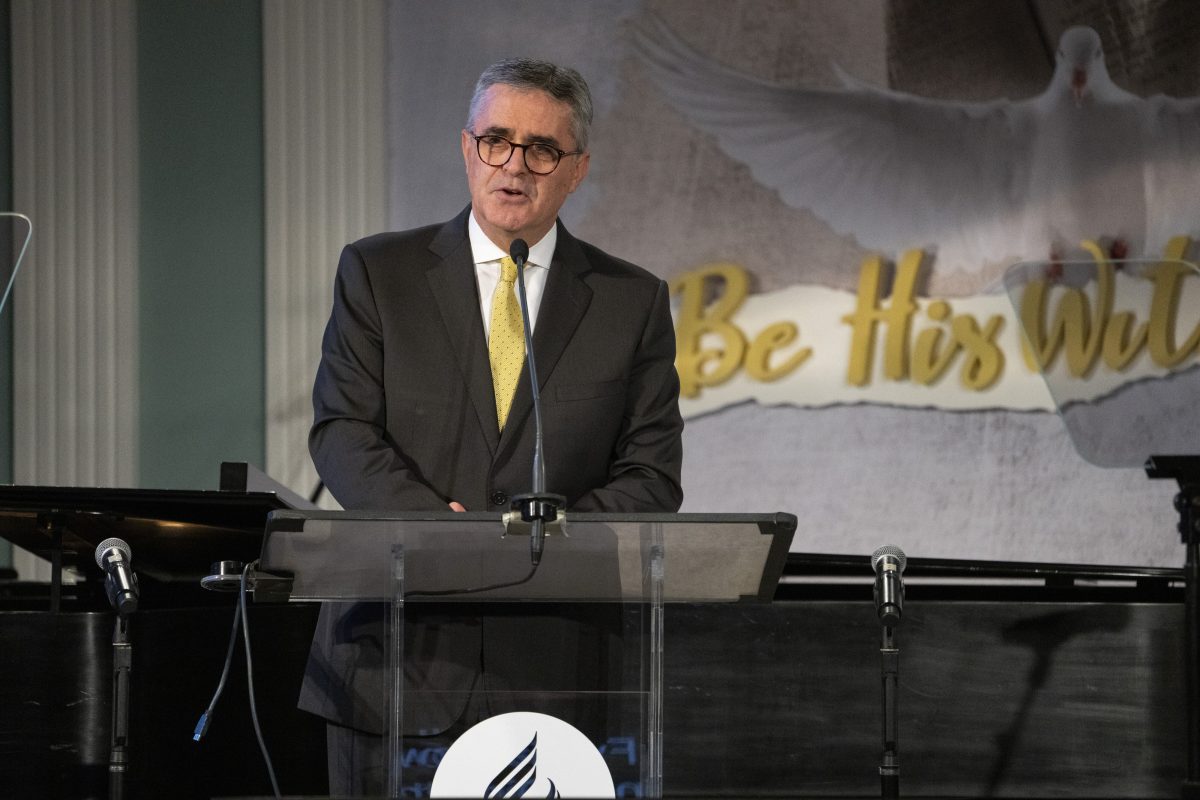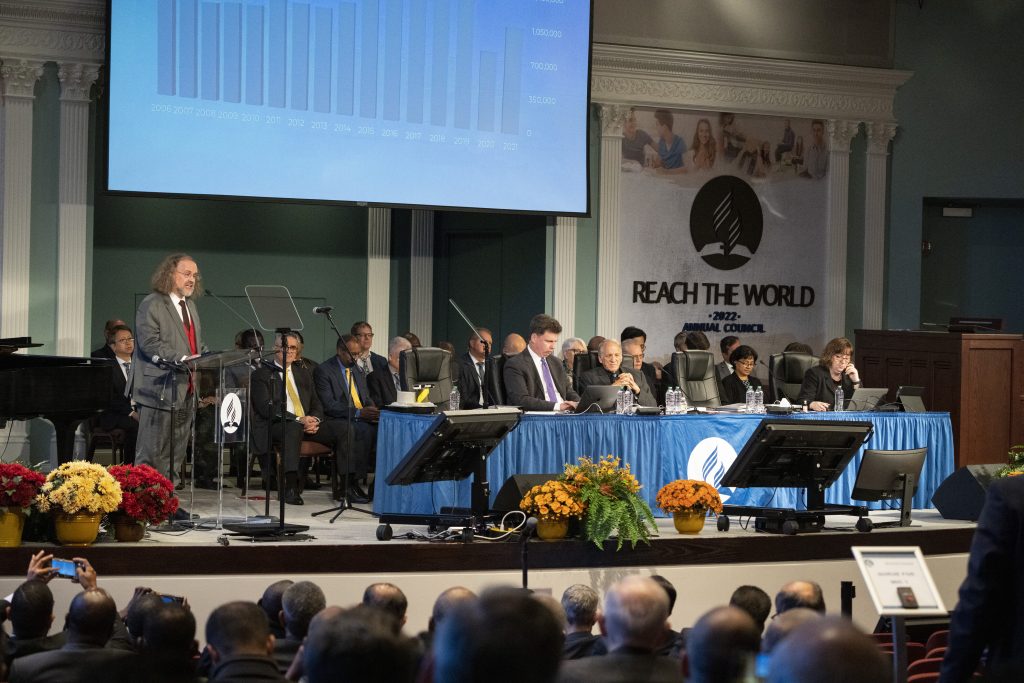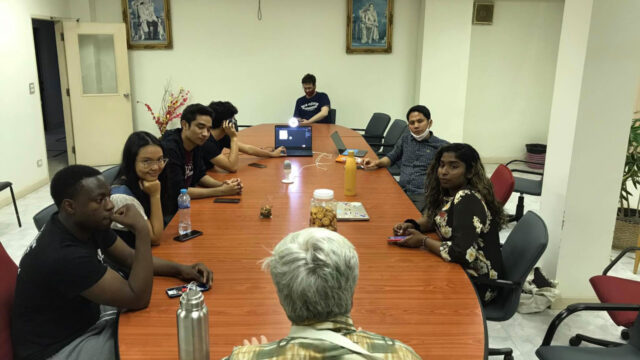Erton Köhler saidwe should never forget we are a missionary church.

On October 9, 2022, Erton Köhler, executive secretary of the General Conference (GC), began his Secretary’s Report at the 2022 Annual Council with a reminder of our purpose as Seventh-day Adventists and as God’s end-time people. Quoting Adventist Church cofounder Ellen G. White, he read, “Our burden for the regions beyond can never be laid down till the whole earth is lightened with the glory of the Lord” (Testimonies for the Church, vol. 6, p. 29).
As Seventh-day Adventists, we are to proclaim “the gospel of the kingdom to all the world [Matt. 24:14],” Köhler reminded delegates. “While the church’s roots are in North America, we have become a global movement. Today, only 6 percent of our membership is based in North America, while the remaining 94 percent is spread across the rest of the world.”
Members’ Accession and Losses
David Trim, director of Archives, Statistics, and Research (ASTR), shared the latest membership figures and compared the last 15 years of data. Prior to the COVID-19 pandemic, membership accessions regularly exceeded one million per year. But in 2020, global accessions declined to 800,000, the lowest since 1997. In 2021, however, accessions once again exceeded one million and evangelism and church planting substantially increased.
In 2020, 1,736 new churches were planted, which Trim called “miraculous in the midst of a pandemic.” However, it was still a 29 percent decrease from pre-COVID numbers.
The same upward trend does not extend to all areas of stewardship, Trim said. While tithes have rebounded and even exceeded pre-COVID figures, offerings have not. Offerings have declined dramatically, indicating the significant decline in the willingness of our church members to give to church programming, including its mission programs.
Trim highlighted an extraordinary fact during his presentation. In 1922, church members gave, in offerings, almost exactly as much as they returned in tithe. Gradually, over the last hundred years, that has changed. Today, offerings amount to just one-third of tithes.
Another area that has seen a negative trend is member losses. Since 1965, approximately 42 percent, or 4 out of 10, church members have left the church. Based on research conducted by ASTR, most of these past members have left without making a conscious decision to do so, Trim said.
Embracing Disciple-Making
Making disciples could help retain members, GC associate secretary Gerson Santos said. “Local churches should aim to create a warm and caring environment for spiritual growth in which youth, adults, and visitors alike feel loved and supported.” The Secretariat department has been working in partnership with other departments to develop strategies and resources to help churches assimilate, equip, and disciple their church members, Santos said.

One of these initiatives is the Nurture and Retention Global Summits, which focuses on discipling, nurturing, and reclaiming members. Santos encouraged church leaders to be intentional in redemptive membership reviews and move away from having mere numbers to having actual members. “Our primary goal is not to boast about the percentage of members present but to reach the unsaved in our community and to care for the inactive in our fellowship,” he said.
Reaching the Unreached
In the following section of the report, Adventist Mission director Gary Krause highlighted statistics and megatrends that challenge Adventist mission. It includes a growing global population, an aging population, international migration, and urbanization.
Trim took a moment to highlight the historical trend of missions. He explained that the “golden age” of the Adventist Church’s foreign missionary program took place in the quarter-century following World War II (from 1946–1970), when 7,385 missionaries were sent into the foreign mission field to reach the unreached. From 1969 to 1970, 970 new missionaries were sent into service, the most in any two-year period in the Adventist Church’s history.
He noted that the rise resulted from a concerted team effort by church administrators, educators, medical leaders, and church members in North America, Europe, Southern Africa, and Australasia. Trim referred to the “mission drift” that has taken place over many years and emphasized the challenge to refocus in how we use our mission resources by identifying mission-critical people groups and locations that have not been reached with the gospel.
Refocusing on Mission
Köhler believes that given these unprecedented times and challenges, the Adventist Church faces a difficult and seemingly impossible mission. “The mission is impossible on our own, but with the Holy Spirit and the outpouring of the latter rain, it will certainly be accomplished,” he said. “With this hope, the world church is moving forward strategically, to work effectively and cooperatively with God, to reach unreached territories and people groups.”
He then shared a proposal designed by Gordon Doss, professor emeritus in the Missiology department of the Seventh-day Adventist Seminary at Andrews University. The proposal seeks to help church leaders and members “to visualize, focus, and refocus [the Adventist] international mission in the 21st century.”
This model considers the developments that have taken place in the last 30-40 years in the Global North and the Global South. It is a model that encourages divisions in the Global South, which have consistently made advances in the gospel mission, to work cooperatively with those in the Global North, which has experienced the opposite effect, Köhler said.
He encouraged leaders to focus on the highest missional priorities in the church and to move resources and mission projects to parts of the world church with less missional capacity, including members, congregations, financial resources, and physical structures.
Across various departments in the GC, resources have been created to help equip, train, and send missionaries to foreign missions, he said.
We Have Been Called
Köhler reminded delegates of Walter Beach’s words, spoken at the 1964 Annual Council: “We are a world missionary church—not just a church with missions in all the world,” said Beach, who served as secretary of the GC from 1954 to 1970.
Köhler added that as we move forward, we need to keep in mind that the “Seventh-day Adventist Church was not called to be a parking lot, but a launchpad for missionaries. We need to move forward in faith,” Köhler said.








